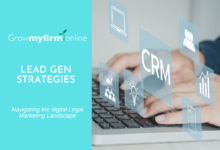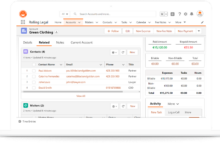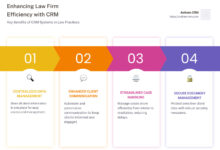Law Office CRM: Streamlining Legal Practice
Law Office CRM systems are revolutionizing how legal professionals manage their practices. Forget endless spreadsheets and scattered notes; a well-implemented CRM centralizes client information, streamlines case management, and boosts team collaboration, ultimately leading to increased efficiency and profitability. This isn’t just about organizing contacts; it’s about transforming the way a law office operates, improving client relationships, and freeing up valuable time for what truly matters: practicing law.
This guide delves into the core functionalities of a Law Office CRM, exploring its key features, benefits, and the process of selecting and implementing the right system for your specific needs. We’ll cover everything from choosing the optimal pricing model to navigating data migration and ensuring effective staff training. By the end, you’ll have a clear understanding of how a Law Office CRM can significantly enhance your firm’s performance.
Defining “Law Office CRM”
A Law Office CRM, or Customer Relationship Management system, is specialized software designed to streamline and improve the efficiency of legal practices. Unlike general-purpose CRMs, it incorporates features specifically tailored to the unique needs and workflows of law firms, enhancing client management, case management, and overall firm productivity.
Law Office CRMs centralize crucial information, allowing for better organization and collaboration within the firm. This centralized approach minimizes the risk of lost or misplaced documents and ensures that all relevant team members have access to the most up-to-date information. This, in turn, improves communication and reduces the chances of errors or missed deadlines.
Core Functionalities of a Law Office CRM
The core functionalities of a typical Law Office CRM include contact management (client details, communication history, etc.), case management (tracking case progress, deadlines, and associated documents), document management (secure storage and retrieval of legal documents), time tracking (billing and productivity analysis), reporting and analytics (performance monitoring and strategic decision-making), and often, integration with other legal software applications. These functions work together to provide a comprehensive view of each client and case, facilitating smoother workflows and improved client service.
Comparison of Law Office CRMs and General-Purpose CRMs
While both Law Office CRMs and general-purpose CRMs manage contacts and interactions, their functionalities differ significantly. General-purpose CRMs offer broad functionalities applicable across various industries, lacking the specialized features crucial for legal practices, such as robust case management, secure document storage complying with legal regulations, and time-tracking features tailored for billing. Law Office CRMs, on the other hand, are built with these specific legal needs in mind, providing features like conflict-of-interest checks, matter-specific task management, and secure document storage compliant with legal and ethical standards. For example, a general CRM might track sales leads, while a Law Office CRM would track case deadlines and court appearances.
Specific Needs of Law Offices Addressed by a CRM
Law firms face unique challenges in managing client information, cases, and internal processes. A Law Office CRM directly addresses these needs by providing solutions for efficient client onboarding, centralized communication, streamlined case management, improved collaboration among legal professionals, secure document storage, accurate time tracking for billing, and insightful reporting to monitor firm performance. The enhanced organization and efficiency lead to better client service, reduced operational costs, and improved profitability. For instance, a Law Office CRM can help prevent missed deadlines by providing automated reminders and alerts, improving compliance and reducing the risk of malpractice claims. Furthermore, accurate time tracking ensures accurate billing, minimizing disputes and maximizing revenue.
Choosing the Right Law Office CRM
Selecting the perfect Law Office CRM is crucial for streamlining workflows, improving client communication, and ultimately boosting your firm’s efficiency. A poorly chosen system can lead to more headaches than help, so careful consideration is key. This section will guide you through the process of finding the ideal CRM for your specific needs.
Factors to Consider When Selecting a Law Office CRM
Choosing the right CRM involves more than just looking at the price tag. Several critical factors need careful evaluation. Ignoring these aspects can lead to dissatisfaction and ultimately, a wasted investment.
- Scalability: Can the CRM handle your current caseload and anticipated growth? Consider features that allow for easy addition of users and cases as your firm expands.
- Features: Does the CRM offer the specific features your firm needs? This includes contact management, case management, document management, time tracking, billing, and reporting. Look for specialized legal features like matter management and conflict-of-interest checks.
- Ease of Use: A user-friendly interface is essential. The CRM should be intuitive for all staff members, regardless of their technical expertise. Look for systems with good training resources and responsive customer support.
- Security: Protecting client data is paramount. Ensure the CRM offers robust security features, including encryption, access controls, and compliance with relevant data privacy regulations (like GDPR or CCPA).
- Integration Capabilities: The CRM should seamlessly integrate with other legal software you use, such as accounting software, e-signature tools, and document management systems. This integration prevents data silos and streamlines workflows.
- Customer Support: Reliable customer support is critical. Choose a provider that offers prompt and helpful assistance via phone, email, or chat. Consider the availability of knowledge bases and online tutorials.
- Budget: Determine your budget before you start your search. Consider not only the initial cost but also ongoing maintenance fees, training costs, and potential integration costs.
Law Office CRM Pricing Models
Law Office CRMs are offered through various pricing models, each with its own advantages and disadvantages. Understanding these models is crucial for making an informed decision.
- Subscription-based models: These models involve recurring monthly or annual fees. They typically offer access to all features and regular updates. The cost can vary depending on the number of users and features included. This model is often preferred for its flexibility and scalability. For example, a small firm might start with a basic plan and upgrade as needed.
- One-time purchase models: These models involve a single upfront payment. However, they often lack regular updates and may require separate fees for support and maintenance. This model can be cost-effective in the long run if your needs remain relatively static, but it can become inflexible as your firm’s needs evolve.
The Importance of Integration with Other Legal Software
Seamless integration with existing legal software is vital for optimizing efficiency and minimizing data entry. Integration prevents data silos, ensuring all information is centralized and accessible. This improves collaboration and reduces the risk of errors. For example, integrating your CRM with your accounting software automates billing and simplifies financial reporting. Similarly, integration with e-signature tools streamlines the process of obtaining client signatures on documents.
Cloud-Based vs. On-Premise Law Office CRMs
The choice between cloud-based and on-premise CRM solutions depends on your firm’s specific needs and priorities.
| Feature | Cloud-Based CRM | On-Premise CRM |
|---|---|---|
| Accessibility | Accessible from anywhere with an internet connection | Accessible only from within the office network |
| Cost | Typically lower upfront cost, recurring subscription fees | Higher upfront cost, lower recurring costs |
| Maintenance | Provider handles maintenance and updates | Requires internal IT resources for maintenance and updates |
| Security | Provider responsible for security, but data breaches are possible | Greater control over security, but requires robust internal security measures |
Implementation and Training
Successfully implementing a new Law Office CRM isn’t just about installing software; it’s about transforming workflows and empowering your team. A well-planned implementation, coupled with thorough training, is crucial for maximizing the system’s benefits and minimizing disruption. This section outlines the key steps involved.
Implementing a new Law Office CRM involves a structured approach to ensure a smooth transition and user adoption. Careful planning and execution are essential for a successful outcome, leading to improved efficiency and client service.
Data Migration Strategies
Data migration is a critical phase. Inaccurate or incomplete data transfer can negate the benefits of the new system. A comprehensive plan should be developed, outlining the steps for transferring data from your existing system (or systems) to the new CRM. This includes identifying data sources, cleaning and validating the data, mapping fields between systems, and testing the migration process. For example, you might prioritize migrating client data first, followed by case details, and then correspondence. A phased approach minimizes disruption and allows for error correction along the way. Consider using a specialist data migration service for large or complex datasets to ensure accuracy and efficiency. Regular backups of your existing data are essential throughout this process.
Step-by-Step Implementation Process
A typical implementation involves several key steps. First, configure the CRM to match your firm’s specific needs and workflows. This might involve customizing fields, creating automated workflows, and integrating with other systems like your accounting software. Next, conduct thorough testing to identify and resolve any issues before a full rollout. This testing phase should involve different users with varying levels of technical expertise. Then, schedule a phased rollout to minimize disruption, starting with a pilot group before expanding to the entire firm. Finally, provide ongoing support and address user queries promptly. For instance, a law firm could start by implementing the CRM in one department before extending it to others.
Effective Training Methods
Effective training is essential for user adoption. A combination of methods is usually most effective. This includes initial classroom-style training sessions covering the system’s core features and functionality. Hands-on training, using realistic scenarios and case studies, reinforces learning. Following this initial training, ongoing support and access to online resources, such as video tutorials and FAQs, are vital for continued learning and troubleshooting. Regular refresher courses can also help maintain proficiency. Consider creating a dedicated “CRM Champion” within the team to act as a point of contact and support for colleagues. This internal resource can be invaluable in resolving minor issues and providing informal assistance.
Ongoing CRM Maintenance and Updates
Regular maintenance is crucial for optimal performance and data integrity. This includes regular data backups, system updates, and security checks. Establish a schedule for these tasks and assign responsibility to specific team members. For example, weekly data backups and monthly security audits are good starting points. Stay informed about system updates and patches to ensure your CRM is running efficiently and securely. Regularly review and refine your CRM workflows to ensure they remain efficient and aligned with your firm’s evolving needs. Consider conducting periodic user surveys to gather feedback and identify areas for improvement.
Closing Summary
Implementing a Law Office CRM is an investment in the future of your legal practice. By centralizing information, automating tasks, and improving collaboration, you can unlock significant efficiency gains, strengthen client relationships, and ultimately, boost your bottom line. While the initial setup requires planning and training, the long-term benefits—from reduced administrative burden to enhanced client satisfaction—make it a worthwhile endeavor for any law office seeking to thrive in today’s competitive landscape. Don’t just manage your cases; master them with the right CRM.



